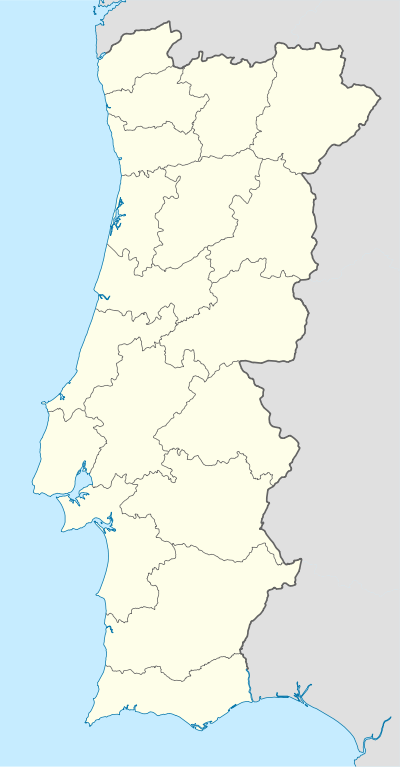Montijo Air Base
| Montijo Air Base Base Aérea do Montijo Base Aérea n.º 6 | |||||||||||||||
|---|---|---|---|---|---|---|---|---|---|---|---|---|---|---|---|
| IATA: none – ICAO: LPMT | |||||||||||||||
| Summary | |||||||||||||||
| Airport type | Military | ||||||||||||||
| Operator | Portuguese Air Force, Portuguese Navy | ||||||||||||||
| Location | Montijo | ||||||||||||||
| In use | 1953 – present | ||||||||||||||
| Commander | Colonel Antonio Carlos da Costa Nascimento | ||||||||||||||
| Elevation AMSL | 46 ft / 14 m | ||||||||||||||
| Coordinates | 38°42′14″N 9°2′9″W / 38.70389°N 9.03583°WCoordinates: 38°42′14″N 9°2′9″W / 38.70389°N 9.03583°W | ||||||||||||||
| Map | |||||||||||||||
 LPMT Location in Portugal | |||||||||||||||
| Runways | |||||||||||||||
| |||||||||||||||
|
Sources: World Aero Data[1] | |||||||||||||||
Montijo Air Base (Portuguese: Base Aérea do Montijo) (ICAO: LPMT) - officially known as Air Base No. 6 (Base Aérea n.º 6) or BA6 - is a military air base located in Montijo, Portugal. The base is home to three transport squadrons and one helicopter search and rescue squadron and provides logistic support to the Portuguese Navy's helicopters based there.
History
The Montijo Air Base started to be built by the Portuguese Navy, before World War II, to replace its Naval Aviation base of Bom Sucesso in Lisbon. The War prevented the good progress of the works and the base ended only to be inaugurated in 1952, as the "Sacadura Cabral" Naval Aviation Centre.
The inauguration of the base happened during the process of the creation of the independent Portuguese Air Force and the transference of the Naval Aviation from the control of the Navy to the new branch.[2]
On March 3, 1953,[3] the Naval Aviation Centre was officially re-designated as Air Base No. 6.[4] However, within the Air Force an independent group originating from the Naval Aviation units, known as "Forças Aeronavais", continued to operate from BA6 in the anti-submarine role. Only by late 1956, early 1957, was the integration of these units in the Air Force complete, with some personnel returning to the Navy and others staying in the Air Force.[2]
In 1993, with the arrival of the Portuguese Navy's first Westland Super Lynx Mk.95 for the Vasco da Gama-class frigates, the air base became home to a naval helicopter squadron.[2]
The Air Force Survival Training Center (Portuguese: Centro de Treino de Sobrevivência da Força Aérea, CTSFA) is based at BA6 with the mission of training Air Force personnel in survival and individual rescue, including in nuclear, radiologic, biologic or chemical warfare environments, as well Explosive Ordnance Disposal.[4]
Tenant units
- Portuguese Air Force
- 501 Sqn. "Bisontes" (Bisons) — tactical transport squadron
- 502 Sqn. "Elefantes" (Elephants) — tactical and general transport squadron
- 504 Sqn. "Linces" (Lynxes) — VIP and MEDEVAC transport squadron
- 751 Sqn. "Pumas" (Pumas) — search and rescue squadron
- Portuguese Navy
- Esquadrilha de Helicópteros da Marinha (Navy Helicopter Squadron)
See also
- List of airports in Portugal
- Portuguese Air Force
- Portuguese Naval Aviation
- Field Firing Range of Alcochete
- Portugal portal
- Aviation portal
References
Notes
- ↑ Airport information for Montijo Airbase at World Aero Data. Data current as of October 2006.
- 1 2 3 "Aviação Naval (Portuguese Naval Aviation) in brief". 20 October 2009. Retrieved 1 March 2013.
- ↑ Portaria N.º 14.281
- 1 2 "Base Aérea nº 6 – Montijo" (in Portuguese). Portuguese Air Force. 24 January 2012. Retrieved 1 March 2013.
Sources
- "Aeronautical infrastructures". 20 October 2009. Retrieved 1 March 2013.
- "Base Aérea Nº 6 – Força Aérea Portuguesa" (in Portuguese). Portuguese Air Force. Retrieved 1 March 2013.
- Lopes, Mário Canongia (1989). Os Aviões da Cruz de Cristo. Lisbon: Dinalivro.
- Tadeu, Viriato (1984). Quando a Marinha tinha Asas. Lisbon.
External links
- Base Aérea Nº 6 – Força Aérea Portuguesa
- Airport information for Montijo Airbase at Great Circle Mapper. Source: DAFIF (effective October 2006).